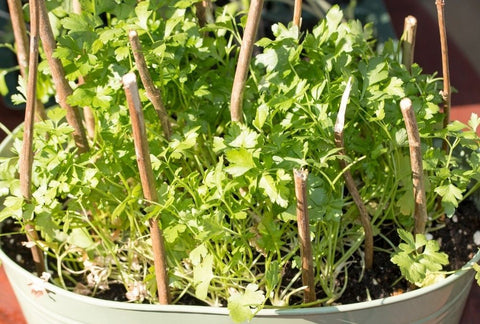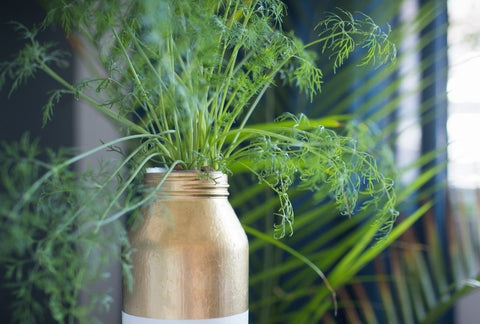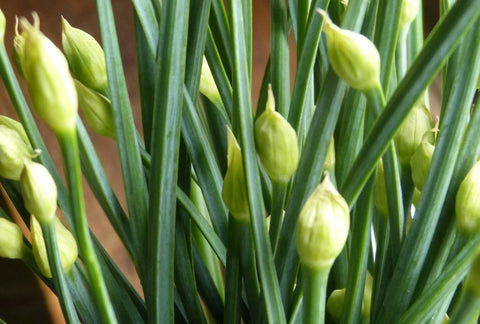Parsley is a pretty universal herb - adding a burst of flavor to your soups, salads, pasta, and sauces. You can even add it to your dog food to freshen your pup's breath! In this blog, we’ll cover everything you need to know to successfully grow parsley indoors - from basic facts, supplies, setup, steps to grow, and how to care for and harvest it.
| Plant type | Biennial |
| Family | Apiaceae |
| Binomial name | Petroselinum crispum |

Timing
Parsley sprouts in 2-4 weeks and can be harvested from Month 3+ on.

Part sun
Parsley needs an equivalent of 4+ hours of direct sun [DLI of 12+ mol/m²/day] so it can grow bountifully.

Care
Growing parsley indoors is very beginner-friendly. You’ll sprout, thin, prune, and harvest.
TABLE OF CONTENTS
Ways to Grow Parsley | Care and Maintenance for Parsley | Timeline & Steps | Cultivars/Varieties
Ways to Grow Parsley Indoors
Growing Parsley Indoors Using Soil vs Hydroponics vs Microgreens
Growing Parsley Indoors Using Soil
To start growing parsley indoors, you need to make sure that the parsley plants are planted in moist soil conditions. If the soil dries out completely the roots will die back and it will be tough for the plant to recover. On the other hand, if the roots are exposed to standing water for too long, they can rot.
Growing Parsley Indoors Using Hydroponics
Of all the culinary herbs, parsley, along with basil, is one of the options that does best in a hydroponic environment. This is due to the fact that it loves moist conditions. You can grow parsley indoors using pretty much any hydroponic setup, including a basic Kratky arrangement (like our Bottle Garden Kits) or more complicated NFT, ebb & flow, or aeroponics setups.
Equipment Needed for Growing Parsley Indoors Using Soil
We prefer using a Ceramic Self Watering Planter filled with a standard potting mix self-regulates to keep the soil at consistent moisture for your indoor parsley plant to thrive (and no watering guesswork for you).
To set one up:
- Fill up the planter with dry soil from the bag, gently tamping down the top.
- Dump the soil into a large mixing bowl and add water until the soil is moist, but not sopping wet (about ½ Cup).
- Mix in 1 tablespoon of the Balanced Blend Plant Food.
If you are using a regular pot instead, it should be a little bit bigger (at least 4" / 1 pint) and will need drainage holes to prevent it from being overwatered. Let the top of the soil dry out between watering.
Here is another self-watering planter that we recommend you use for your indoor parsley plant:
 |
| XS Self Watering Planter by Wet Pot |
Equipment Needed for Growing Parsley Indoors Using Hydroponics
Personally, we’ve not found that the incremental performance of a sophisticated hydroponics setup is worth the extra cost and complexity. Therefore, our recommendations for growing parsley hydroponically indoors are either:
- A simple Kratky setup, such as in a mason jar or bottle garden kit is great for getting started.
- If you’re looking for something a bit bigger, then check out the Aerogarden range. These countertop units are relatively affordable and use basic aeroponic technology. If you do go this route, be sure to check out the replacement part options we offer.
Growing Parsley Indoors as Microgreens
You can definitely grow parsley as microgreens, especially curly leaf and flat leaf varieties. Take note though, that parsley is considered slow-growing microgreens, so if you’d like to be able to eat your microgreens in less than a week, then you should look into other plants instead.
Grab a copy of our eBook to learn more about all the different ways you can grow parsley (and more!) at home.
Care and Maintenance of Parsley Indoors
Lighting for Growing Parsley Indoors
Out of all edible plants, parsley plants have some of the lowest light needs. That said, they still need at least 4+ hours of direct sunshine a day. While you might be lucky enough to have a bright windowsill that works, most of us need to use a grow light (especially during the winter).
For an introduction to grow lights, head over to our post on grow lights for indoor gardeners. We’ve also got a buying guide for screw-in types.

How bright should your grow light be?
Parsley plants need the equivalent of 4+ hours of direct sunlight [DLI of 12+ mol/m²/day] to grow their best. In order to provide an equivalent amount with a grow light, it needs to be pretty bright! A grow light such as the 24W Sansi bulb should be placed 6 inches away from the top of the plant. This will give your PPFD (the standard measure of brightness) of 500 μmol/m²/s. Learn more about optimal grow light setup for your indoor garden here.
How many hours per day do your parsley plants need under a grow light?
Parsley plants are known as “long-day” plants. When they sense over 12 hours of light per day, they’ll start the end of their lifecycle and work on making seeds. We want to keep them in an earlier stage so we can keep harvesting the leaves, so we recommend setting up a timer to leave it on for only 8 hours per day.
What is The Right Temperature for Your Indoor Parsley Plant?
Extend your harvest by keeping the temperatures cool
Parsley is known as a “cool weather crop.” If it senses warming temperatures it will “bolt” - send up flowers and become bitter in the process. Where you plant them can have some effect on the temperature - lower positions on a growing rack and ceramic planters tend to run cooler. It's best to avoid windows that get really hot (like bay windows).
Water and Humidity
Herbs such as parsley thrive on consistent moisture but can suffer if they’re waterlogged, so make sure to water them regularly especially if you’re using soil. To avoid your indoor parsley plant being waterlogged, make sure to use a pot with drainage, or just use self-watering pots, as mentioned above.
Nutrients and Fertilizers
Parsley likes to start with nutrients that are equal parts nitrogen, phosphorus, and potassium (with NPK numbers like 10-10-10). For this Balanced Blend, we recommend: Dr Earth All Purpose.
Once they are growing, it’s better to use plant food that is high in nitrogen (with NPK numbers like 10-5-5). For this Herb Blend, we recommend: Joyful Dirt All Purpose.
Moving Your Indoor Parsley Plant Outdoors
Parsley is a cool-weather crop, which can likely withstand being moved outdoors in early Spring or staying outdoors until some time in Fall. To learn more about how to grow your parsley outdoors, check this out.
Timeline and Steps on How to Grow Parsley Indoors
Best Setup for Indoor Parsley Plants
Below is the best setup (and a very easy one!) for growing your parsley indoors. You’ll need:
Planter:
Ceramic Self Watering Planter (preferred) or pot that is at least 4" / 1 pint.
Soil:
Free-Draining Mix
Plant Food:
At the start: Balanced Blend. This should be equal parts nitrogen, phosphorus, and potassium (with NPK numbers like 10-10-10).
On-going: Herb Blend. This should be high in nitrogen (with NPK numbers like 10-5-5).
Grow Light:
A strong grow light that can give the equivalent of 4+ hours of direct sun [DLI of 12+ mol/m²/day].
Growing Parsley from Seed vs Cutting vs Nursery Plant Indoors
New parsley plants can be started from seed, propagated from an established plant, or purchased live at many garden centers. We prefer to sprout from seed or propagate from a stem cutting, as it results in plants that are adapted to your growing conditions and limit the chances that you accidentally bring home pests.
How to Plant Parsley Seeds

Parsley grows quickly from seed. Plant 1 site in a 4" / 1-pint container. In larger containers, space sites 4" apart. For each site plant 2 seeds 1/4 inches deep. Keep the soil warm (40-90°F, ideally 70°F). Sprouts typically appear in 14 days but can be as quick as 7 days or as long as 21 days depending on your conditions. To speed things up, you can soak them in water for 12-24 hours before planting.
Propagating Parsley: How to Clone from a Stem Cutting

If you’ve already got a Parsley plant you love (or a friend does!) you can easily “clone” it with just sharp scissors and a clean glass of water. First, cut a couple 6” shoots of new growth (avoid anything woody). Next, remove the lower leaves, so the bottom half is just stem. Place in a glass of 3” of water, making sure the cut leaf spots are underwater. Place the glass on a bright windowsill and change the water every few days. In a couple of weeks, roots should emerge and you can transplant them into your container. While using additional rooting hormones won't hurt, it’s not necessary with Parsley plants.
- Cut 6” section of new growth
- Remove leaves halfway and place them in the water on a sunny window sill
- Wait 7-14 days for a few ½ inch roots to form and carefully transplant into its final container
How to Transplant Parsley

Live starter plants give you a big jump start on your first harvest. When you’re in a garden center - pick the bushiest plant available (tall and lanky ones will be weak growers) and give it a good inspection for pests. Leaves should be dark green without holes, spots, or curled edges. A best practice is to actually “quarantine” your plant for about a week after bringing it home to make sure it's free and clear of ride-on pests. Ensuring it’s pest and disease-free it’s time to transplant your seedling into its final home.
- Remove some soil from its final planter - leaving enough space for the bottom of the seedling to be just higher than the soil surface.
- Hold on to the base of the stem with one hand, and turn the pot over while gently pulling the seedling. Giving the pot a few squeezes can help dislodge it.
- Place in its final container and fill around it with soil so that it’s tight, but not compacted.
Week 2-4: Check for Sprouts
You could see seedlings in as little as 7 days (though 14 days is more typical). If it’s been 21 days and you still don’t have any sprouts, it’s likely that your setup is too cold.
Week 4: Thin Your Seedlings

Thin your planter to only have 1 seedling per site - leaving the largest plant. If you are using the recommended planter (at least 4" / 1 pint) this will mean you’ve got 1 plant after thinning. By getting rid of the smaller seedlings, you’re allowing the biggest and strongest one to flourish by reducing its competition for water, food, and space. If your seedlings are under 1 inch, stretching out, or folding over, it folding over, it’s likely that they don't have quite enough light.
Week 5: How to Prune Indoor Parsley Plants

You’ll notice how all the stems and leaves of Parsley grow from a single, central point (called radial growth). The plant puts out new leaves in the center and pushes old leaves outward, getting bigger and bushier over time. Pruning and harvesting are one-in-the-same as Parsley. Once the plant has at least 3 separate stems coming from the base, take one of the outside leaves and cut it close to the base (½” above is fine). It’s good to leave at least 2/3rds of the plant left to regrow. If you only want a tiny amount of herbs, you also can clip the top of an individual stem – just be sure to leave some leaves on that stem, otherwise it won’t grow back.
Month 3+: How to Harvest Parsley
Wait until the bottom leaves have at least 3 segments to harvest and always harvest the outer leaves, leaving the inner ones to mature.
How to Use Your Freshly-harvested Parsley in Cooking
Just like most herbs, parsley is also a common ingredient used by the most prominent chefs around the world to ordinary food lovers at home. Parsley leaves can be used in many ways:
- Blended/processed into dips/sauces
- Garnish/toppings on sandwiches, pizza, pasta, soups
- Blended into smoothies
Check out some more of our favorite parsley recipes here.
How to Preserve Parsley
There are several ways to preserve or keep your herbs such as parsley fresh, and here are just some of the easiest and the ones we recommend the most:
- Lazy person technique: It involves keeping the fresh herbs in their original packaging and simply storing them in the fridge.
- Storing the herbs in a glass of water inside the fridge: You can do this by cutting the end of the stem of your herb, filling a glass jar or cup with water, and placing your herb inside. Almost like a vase or bouquet of herbs!
- Keep in a glass of water under natural lighting.
- Wrap loosely in a damp paper towel.
- Freeze them herbs! Yes, you can freeze fresh herbs such as parsley, to use at a later time! All you need are some ice cube trays and a freezer, and you’re all set.
Learn more about how to preserve and keep your herbs and parsley fresh here.
Month 6+: End of Life
Parsley is a biennial plant which means it naturally sets seed when it experiences hot summer temperatures.
If you’d like to learn about the dozens of other herbs, fruits, and vegetables that you can grow indoors then grab a copy of our free eBook below.
Growing Parsley Indoors and the Best Varieties to Grow
To answer your question about “which parsley varieties should I grow indoors,” the two major varieties of parsley are curly-leaf and flat-leaf. There are two other varieties, which are not as common and are used/cooked differently: Hamburg and Japanese parsley.
Below is a table where we summarized each of their unique features. We also included the product links for your reference.
| Variety | Curly-leaf | Flat-leaf (Italian) | Hamburg | Japanese |
| Why We Like Them | It’s mainly used in salads and for garnishing. It’s usually smaller in size than the rest with controlled growth. | This is the most common variety of parsley used for cooking. It’s stronger, vibrant, and sweeter than the rest. | It’s less common than the other two varieties, and it’s mainly grown for its edible, swollen parsnip-flavored roots that are used as vegetables. | It is used as a seasoning, a potency tonic, and the leaves and roots are cooked as a vegetable while sprouts are eaten in salads. |
| Purchase Link | Amazon | Urban Leaf | Amazon | Amazon |
We hope that this blog has given you everything you need to know about growing parsley indoors. In case you have any questions, just leave a comment below.









There are no comments for this article. Be the first one to leave a message!